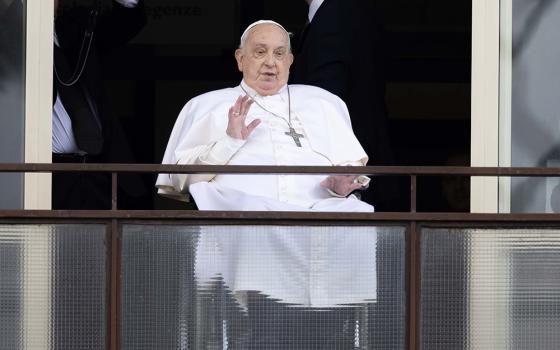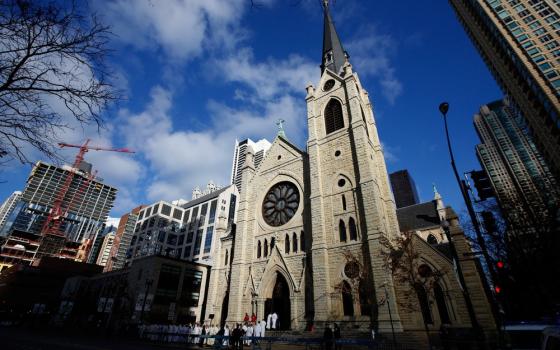Pope Francis, with the publication of Amoris Laetitia (The Joy of Love), has offered a broad and deep reflection on the myriad (and often messy) issues concerning marriage, the family and human sexuality.
And in doing so, the 79-year-old pope has also put forth a clear vision of Christian discipleship. It is one based more on personal responsibility and prayerful discernment than on the mere following of church rules.
Furthermore, in this same document he has sketched out a profile of the ordained minister. Both priests and bishops are to be servant-leaders who, with mercy and patience, humbly accompany, dialogue and collaborate with their people as fellow disciples. The pope doesn't want pastors who harangue Catholics who fall short of the mark with rules and moral laws "as if they were stones to throw at people's lives."
In essence, he is re-proposing the model of discipleship and servant-leadership that emerged from the Second Vatican Council (1962-65). He is attempting to pick up the journey that the church had embarked upon in the first decade or so following Vatican II, but one that John Paul II halted and began to "correct" and recalibrate early on in his long pontificate (1978-2005).
Pope Francis' rejoining of that earlier journey should be greatly encouraging for the many so-called Vatican II Catholics who have remained actively involved in the church despite the Wojtylan U-turn. And it could offer new hope to those many former Catholics who feel that the church under the sainted Polish pope abandoned them when it changed course.
But there is a serious challenge here. The vast majority of the world's bishops, younger clergy (under the age of 45 or so) and seminarians are squarely on the road that St. John Paul II and his German successor built. Too many find themselves greatly conflicted by Francis and all that he is doing to shake up and renew the church.
A good number of them are rigid personalities obsessed with the "clarity" of doctrine, who find their identity in a churchy world of black and white (like the uniform they wear) and exude confidence in being the recognized and unchallenged upholders of the Truth that they believe is possessed by the church alone.
This type of cleric (and the enabling clericalist lay people that continue to put priests on a pedestal) will be of little help in implementing the vision Pope Francis has unveiled in Amoris Laetitia.
And by the looks and sounds of things it doesn't seem like the seminaries -- at least here in Rome and in most places in the United States -- offer much hope of changing that any time soon.
The Pontifical North American College here in the Eternal City is but one example. I have some familiarity with the place, since I was a seminarian there from 1986 to 1988 before discontinuing studies for the priesthood. Friendships I made with some very fine people -- some who are now ordained (several as bishops), others who have left the active ministry -- does not alter my strong conviction that, like most other seminaries, it is built on an inadequate model and mentality for preparing parish priests for today.
For a long time NAC held the distinction for having one of the worst early attrition rates among all American seminaries. It is difficult to locate records that the bishops are not particularly proud of, but it is said that an unusually high number of NAC alumni leave the priesthood shortly after ordination compared to those from other seminaries.
That is not exactly a badge of honor for an institution that has come to epitomize and is designed to perpetuate the type of episcopal leadership and model of church that has emerged over the past three decades with the increasingly conservative U.S. hierarchy.
After all, it is under the authority of a board of governors and the U.S. Conference of Catholic Bishops. Its current chairman is Archbishop John Myers, the Opus Dei-affiliated Archbishop of Newark. Bishops, cardinals and wealthy donors are frequent guests at the college. When now-Cardinal Timothy Dolan was rector (1994-2001) he added a number of suites and apartments exclusively for their use. "NACkers," as the residents are called, are used to the constant presence of princes of the church and movers and shakers in the world.
The NAC was established in 1859, back in the reign of Pius IX, when a handful of students lodged in a modest building near the Trevi Fountain. Since the 1950s it has been situated on the Janiculum Hill where it enjoys a commanding view of St Peter's Basilica and the Vatican, looking in one direction, and a spectacular panorama of the entire city of Rome, facing the other way.
The "new" place was purposely designed big and brash (built in the blocky Fascist architecture) to show the Holy See and the rest of the Catholic world that the young American Church had money and could hold its own.
"It's not home, but it's much," we used to say.
Early on it became known as the place that prepared future bishops for the United States by equipping its episcopal leaders with a Roman pedigree. In fact, from the earliest part of the last century up to 1974 even the rector was almost always a bishop. The last in that line was the late James Hickey (1969-1974) who would go on to become the cardinal archbishop of Washington.
A number of today's current U.S. bishops -- including Cardinals Raymond Burke, James Harvey, Daniel DiNardo and Timothy Dolan -- were at the NAC at some point during his five years as rector. But the Hickey Boys, as they were known, almost became the last generation of this bishop factory.
Over the next sixteen years (1974-1990) a succession of three rectors -- Msgrs. Harold Darcy, Charlie Murphy and Larry Purcell -- tried to prepare the students with the servant-leadership model that was in vogue after Vatican II. They added pastoral training and ministry programs and, with a less regimented community atmosphere, appealed to the maturity and responsibility of the students to cooperate with their efforts.
But by the early 1980s something changed. A new generation of more conservative U.S. bishops increasingly began sending seminarians to NAC who self-identified as being conservative or traditional. Emboldened by their bishops, they were unabashedly critical of the college's "liberal" faculty.
Years later a student at the college described these as the "lax years" when he discovered that I was an alumnus.
Seminary is a time for discernment and, on the face of it, Msgr. Purcell and his formation team were hired by the U.S. bishops to help us discern, and perhaps even make a judgment, about whether or not we were truly called to priesthood. But it became clear that there were those forceful bishops who sent students to NAC already determined to ordain them no matter what the formation staff said.
A major shift occurred at the college in 1990 and the stars began to align again when Msgr. Edwin O'Brien of New York was appointed rector. A favored son of Cardinal John O'Connor, he immediately tightened up discipline and the seminary dress code. Those who have described NAC as the West Point of U.S. Catholic seminaries take their cue from the now-Cardinal O'Brien, currently the Rome-based Patron of the Knights of the Holy Sepulcher.
Known for insisting that his seminarians keep their shoes shined, hair neatly combed and shirts pressed, he actively courted wealthy Catholics to help fund the college. Among other initiatives he began what has become the annual Rector's Dinner, a gala evening to entertain the benefactors and wine and dine U.S. bishops and Vatican cardinals.
The 24th edition of the dinner took place this past Thursday and "donations" started at $450 per plate. The top brass of the U.S. hierarchy was there, including the soon to be retiring apostolic nuncio to Washington, Archbishop Carlo Mario Viganò.
The enrollment at the start of his academic year was 252 students, an all-time record. That's about a hundred more residents than in the 1980s. Cardinal Dolan can be credited with initiatives to drive up the numbers. During his years as rector the mantra, "200 for 2000," was part of a campaign to increase the college's population to two hundred seminarians for the year of the Great Jubilee. It didn't happen then, but the college is filled to overflowing now.
This, too, has been part of an effort by the U.S. bishops to convince their Vatican minders that priestly vocations in America are dramatically on the rise -- which is patently false. In reality, the more powerful leaders in the American hierarchy encourage bishops to send more students to Rome, depleting other seminaries even to the point that some of them -- like American College in Louvain, Belgium, which was founded before NAC -- have been forced to close or merge.
Msgr. James Checchio, who was rector from 2005 until this past January, has overseen this period of unparalleled enrollment. The New Jersey native, who will be ordained Bishop of Metuchen next month, also carried out the construction of a 10-floor tower that has added another 36,000 square feet of space for classrooms, chapels and lounges to the NAC expanse. It was finished in only 18 months, a miracle in a country where it's notoriously complicated to get the various construction permits. And the project reportedly cost only $7 million or so, which was paid by a generous benefactor.
Bad institutions can sometimes do great harm to good people. And it's hard to see how places like NAC are preparing future priests to have the "smell of the sheep" or helping them embrace Pope Francis' dream of "a poor Church for the poor.
[Robert Mickens is editor-in-chief of Global Pulse. Since 1986, he has lived in Rome, where he studied theology at the Pontifical Gregorian University before working 11 years at Vatican Radio and then another decade as correspondent for The Tablet of London.]
Editor's note: We can send you an email alert every time Robert Mickens' column, A Roman Observer, is posted. Go to this page and follow directions: Email alert sign-up.




